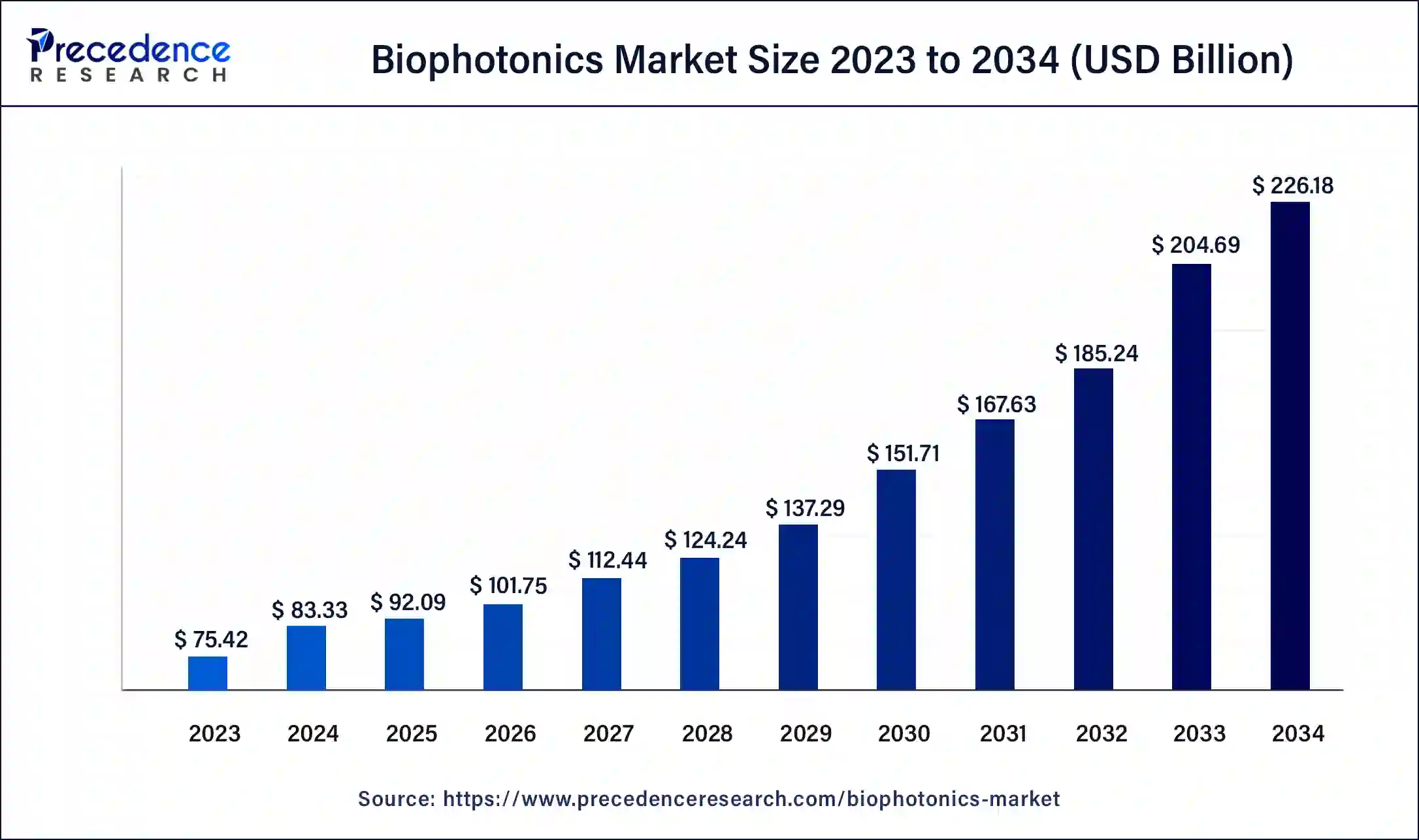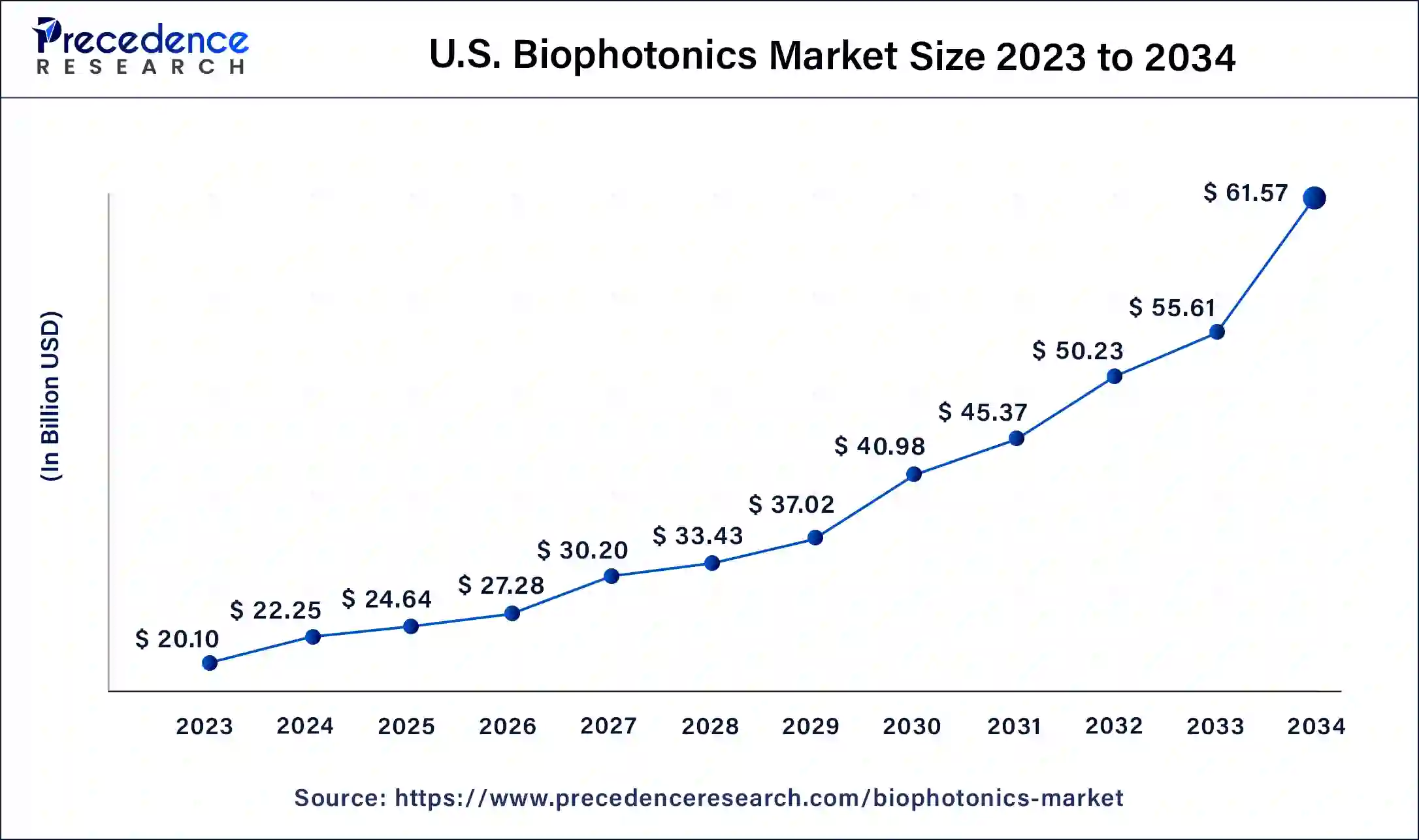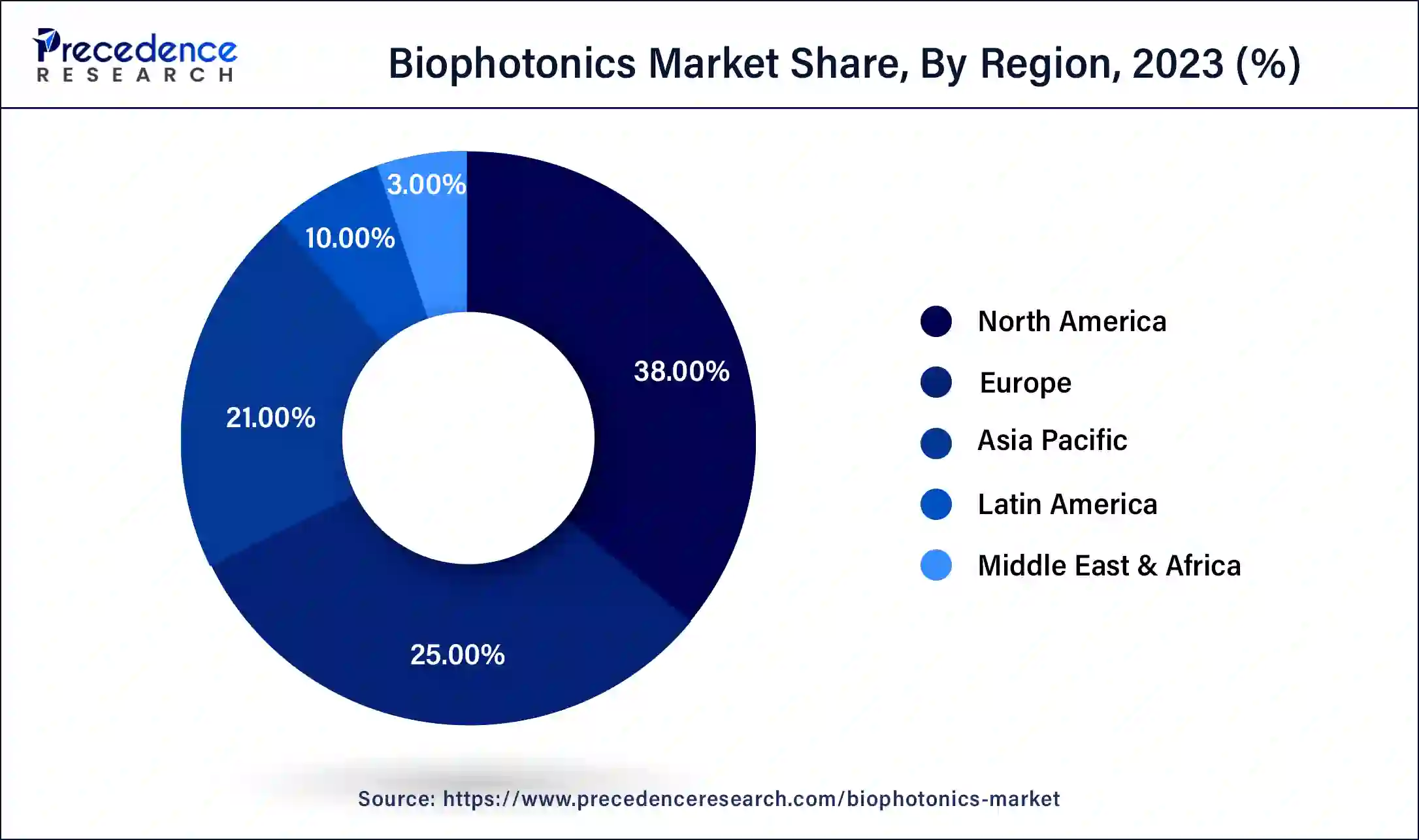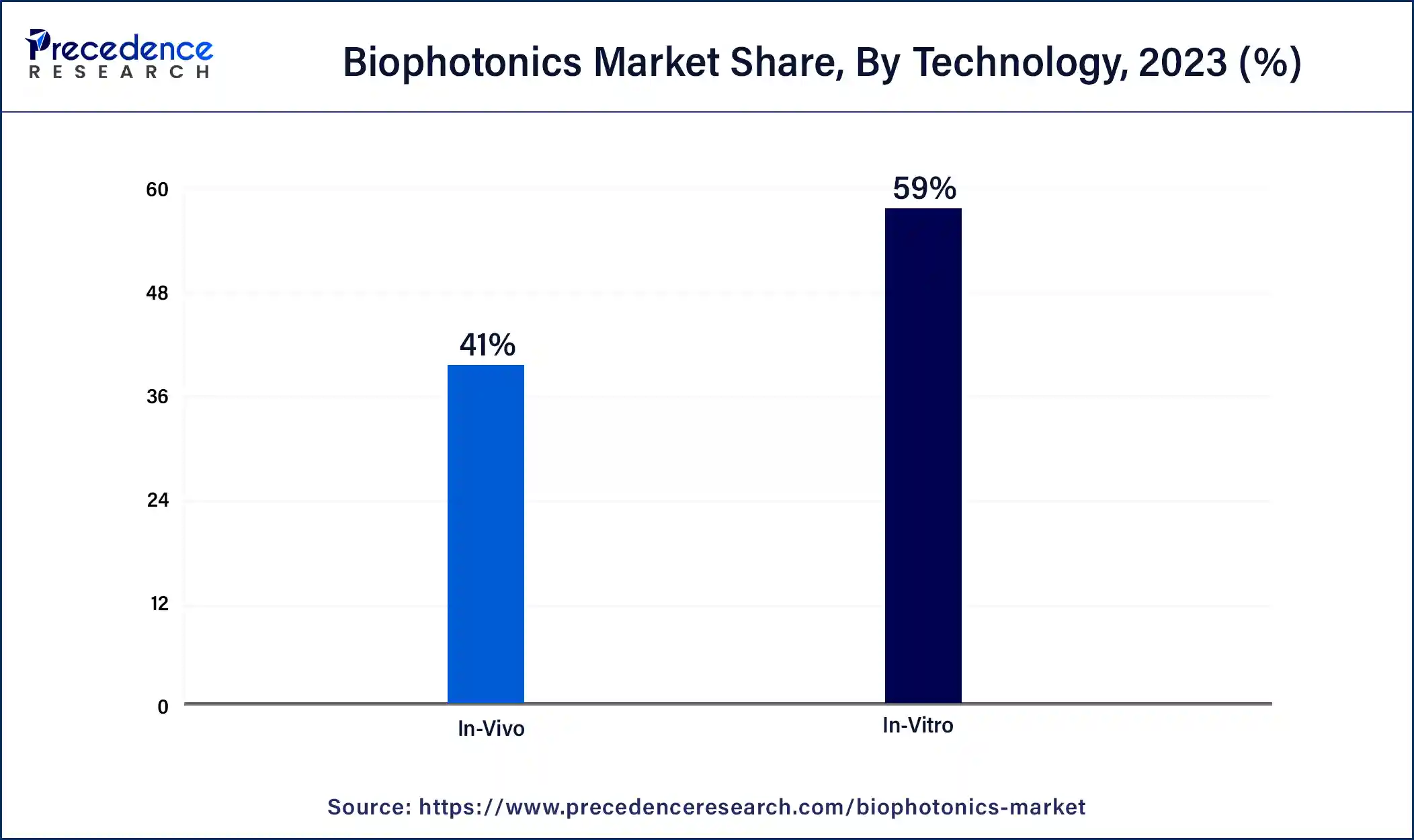The global biophotonics market size accounted for USD 83.33 billion in 2024, and is expected to reach around USD 226.18 billion by 2034, expanding at a CAGR of 10.5% from 2025 to 2034. The North America biophotonics market size reached USD 28.66 billion in 2023.

The U.S. biophotonics market size was estimated at USD 22.25 billion in 2024 and is predicted to be worth around USD 61.57 billion by 2034, at a CAGR of 10.70% from 2025 to 2034.

North America held the largest market share of 38% in 2024 due to robust research and development activities, a well-established healthcare infrastructure, and high adoption rates of advanced medical technologies. The region's strong focus on precision medicine, coupled with substantial investments in biophotonics applications like imaging and diagnostics, contributes to its market dominance. Additionally, collaborations between academic institutions, research organizations, and industry players’ foster innovation, further solidifying North America's position as a leader in the evolving field of biophotonics.

The Asia-Pacific region is poised for rapid growth in the biophotonics market due to increasing healthcare investments, rising awareness of advanced medical technologies, and a growing aging population. The region's expanding research and development activities, coupled with a focus on improving healthcare infrastructure, contribute to the surge. Additionally, the demand for innovative diagnostic and imaging solutions in countries like China and India, coupled with supportive government initiatives, positions the Asia-Pacific biophotonics market for substantial expansion, offering significant opportunities for market players and fostering advancements in healthcare technologies.
Meanwhile, Europe is experiencing notable growth in the biophotonics market due to increased investments in research and development, supportive government initiatives, and a rising focus on healthcare innovation. The region's strong emphasis on precision medicine and personalized healthcare, coupled with advancements in biophotonics technologies, has fueled market expansion. Additionally, collaborations between academic institutions and industry players have accelerated the adoption of biophotonics solutions. This growth is further propelled by the increasing application of biophotonics in areas like diagnostics, therapeutics, and life sciences, positioning Europe as a key player in the global market.
The Middle East and Africa are expected to grow significantly in the biophotonics market during the forecast period. The growing healthcare sector is increasing the development, as well as the adoption of biophotonics-based biosensors, optical imaging, etc. This, in turn, is also leading to new research. Additionally, the increasing occurrences of diseases are increasing the demand for early diagnostic and treatment approaches, which in turn, is increasing the use of biophotonics in the development of appropriate diagnostic approaches. Thus, all these factors, along with the government support, are promoting the market growth.
Biophotonics is an interdisciplinary field that involves the application of light-based technologies in biological and medical sciences. Using the principles of optics and photonics, biophotonics explores the interaction between light and biological tissues to develop advanced tools for imaging, diagnostics, and therapy. This field harnesses the unique properties of light to study and manipulate biological materials at the cellular and molecular levels. Biophotonics plays a crucial role in various medical applications, such as non-invasive imaging techniques, laser-based therapies, and optical diagnostics. By utilizing light to probe and analyze biological structures, researchers and healthcare professionals gain valuable insights into the functioning of living organisms. The applications of biophotonics continue to evolve, contributing to advancements in medical research, diagnostics, and treatments with the potential to improve patient outcomes and enhance understanding of the complexities of living systems.
Biophotonics Market Data and Statistics
| Report Coverage | Details |
| Global Market Size in 2034 | USD 226.18 Billion |
| Global Market Size in 2025 | USD 92.09 Billion |
| Global Market Size in 2024 | USD 83.33 Billion |
| Growth Rate from 2025 to 2034 | CAGR of 10.5% |
| Dominated Region | North America |
| Fastest Growing Market | Asia Pacific |
| Base Year | 2024 |
| Forecast Period | 2025 to 2034 |
| Segments Covered | End-use, Technology, Application, and Region |
| Regions Covered | North America, Europe, Asia-Pacific, Latin America, and Middle East & Africa |
Rising geriatric population
The surging demand for biophotonics in the market is closely tied to the increasing global population of seniors. As people age, there is a higher likelihood of health issues, and biophotonics plays a crucial role in addressing these concerns. Biophotonics technologies offer advanced diagnostic tools and imaging solutions that are particularly beneficial for the elderly. These tools aid in early detection of age-related conditions, enabling timely interventions and personalized healthcare. The rising geriatric population, with its associated health challenges, propels the need for non-invasive and effective medical solutions. Biophotonics caters to this demand by providing innovative approaches to diagnostics, contributing to a more comprehensive understanding of age-related diseases. As the aging demographic grows, the market for biophotonics is expected to expand further, offering valuable contributions to improving healthcare outcomes for seniors around the world.
Limited accessibility in developing regions
Limited accessibility in developing regions serves as a significant restraint for the biophotonics market, hindering its widespread adoption and potential impact on healthcare. In these regions, inadequate infrastructure, including a lack of reliable power sources and limited healthcare facilities, poses challenges for the integration of advanced biophotonics technologies. The high costs associated with setting up and maintaining these technologies further exacerbate the accessibility issues, preventing many healthcare providers in developing areas from incorporating biophotonics into their practices.
Moreover, economic constraints in these regions limit the financial resources available for healthcare investments, making it difficult for institutions to afford the necessary equipment and training. As a result, the transformative benefits of biophotonics, such as advanced diagnostics and personalized medicine, often remain out of reach for populations in developing regions. Efforts to address these accessibility challenges, including initiatives for cost-effective solutions and targeted infrastructure development, are crucial for ensuring that the potential advantages of biophotonics can be extended to underserved populations worldwide.
Advancements in research and development
Advancements in research and development (R&D) serve as a catalyst for creating significant opportunities in the biophotonics market. Ongoing innovations in biophotonics technologies, such as enhanced imaging modalities and sophisticated spectroscopy tools, pave the way for transformative applications in medical diagnostics and life sciences. These developments not only contribute to the refinement of existing tools but also lead to the creation of novel solutions, expanding the market's potential. As R&D efforts progress, the continuous improvement in biophotonics capabilities addresses the evolving needs of healthcare and research communities.
The exploration of cutting-edge techniques and methodologies provides opportunities for the development of more precise and efficient diagnostic tools, ultimately contributing to advancements in personalized medicine and therapeutic interventions. The collaborative efforts of researchers and industry players in pushing the boundaries of biophotonics R&D underscore its role as a dynamic and evolving field, offering promising opportunities for the future of healthcare and scientific discovery.
The medical diagnostics segment held the largest market share in 2024. The medical diagnostics segment in the biophotonics market refers to the use of light-based technologies for accurate and non-invasive medical testing. Biophotonics plays a vital role in this field by enabling advanced imaging and diagnostic tools, facilitating early disease detection and monitoring. Current trends include the development of portable and point-of-care biophotonics devices, enhancing accessibility to rapid and efficient diagnostics. Additionally, the integration of biophotonics with artificial intelligence is a notable trend, augmenting diagnostic capabilities and contributing to the evolution of precision medicine in medical diagnostics.
The non-medical application segment is anticipated to witness rapid growth at a significant CAGR during the projected period. In the biophotonics market, the non-medical application segment encompasses various uses beyond healthcare. This includes applications in agriculture, environmental monitoring, and industrial processes. A notable trend in this segment is the adoption of biophotonics for agricultural diagnostics, such as soil and crop analysis. Additionally, environmental monitoring benefits from biophotonics tools for assessing water quality and pollution levels. As industries recognize the versatility of biophotonics, the non-medical application segment continues to expand, offering solutions for diverse fields beyond traditional healthcare settings.
The in-vitro segment held the largest share of the market in 2024. The in-vitro segment in the biophotonics market pertains to technologies that apply light-based methods to analyze biological samples outside the living organism. This includes techniques like fluorescence spectroscopy and imaging used for studying cells, proteins, and DNA in controlled laboratory settings. Recent trends indicate a growing adoption of advanced in-vitro biophotonics technologies for more accurate and efficient analysis, contributing to advancements in medical research, drug development, and diagnostics, with a focus on enhancing precision and reducing the need for invasive procedures.

The in-vivo segment is anticipated to witness rapid growth over the projected period. In the biophotonics market, the in-vivo segment refers to technologies that enable the study and imaging of biological processes within living organisms. This involves non-invasive methods to visualize and understand biological structures and functions in real-time. A notable trend in the in-vivo biophotonics market is the increasing adoption of advanced imaging techniques like fluorescence imaging and multispectral imaging, allowing researchers and healthcare professionals to gain deeper insights into physiological and pathological processes within living organisms, fostering advancements in diagnostics and therapeutic interventions.
The analytics sensing segment held the largest share in 2024. In the biophotonics market, the analytics sensing segment involves the use of photonics technologies for data analytics and sensing applications in biological and medical contexts. This segment encompasses the development of advanced sensors and analytical tools that utilize light to gather precise information about biological materials. A key trend in this sector is the integration of analytics sensing with artificial intelligence, enhancing data interpretation and enabling more accurate diagnostics. The growing demand for real-time, high-resolution data in biophotonics analytics sensing is driving continuous innovation and expanding applications in medical research and diagnostics.
The microscopy segment is anticipated to witness rapid growth over the projected period. In the biophotonics market, the microscopy segment involves the use of light-based techniques to visualize and analyze biological structures at the microscopic level. This application plays a crucial role in various fields, including medicine and life sciences, by enabling detailed imaging of cells and tissues. Recent trends in biophotonics microscopy include the integration of advanced imaging technologies, such as super-resolution microscopy and multiphoton microscopy, offering higher resolution and improved capabilities for studying complex biological processes with greater precision. These trends contribute to enhanced research outcomes and diagnostic applications in the field of biophotonics.
By End-use
By Technology
By Application
By Region
For inquiries regarding discounts, bulk purchases, or customization requests, please contact us at sales@precedenceresearch.com
No cookie-cutter, only authentic analysis – take the 1st step to become a Precedence Research client